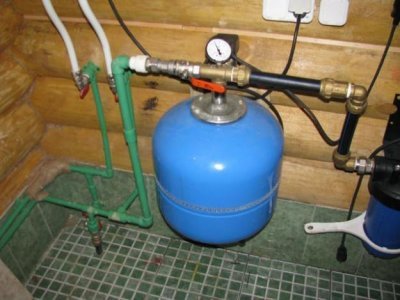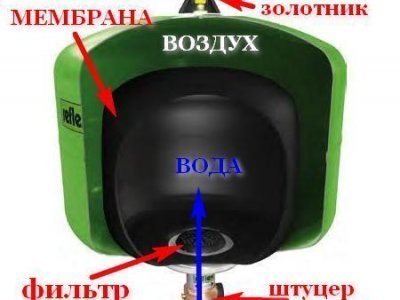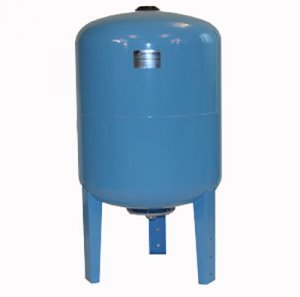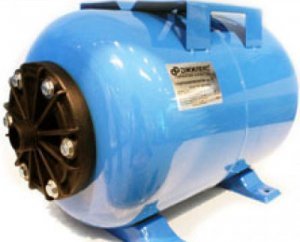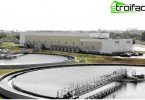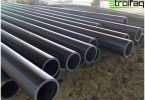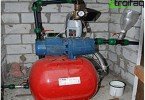Hydraulic accumulators for water supply
When opening a faucet in a country house, it is rare for any owner to think about where the water comes from. Of course, everyone knows that the source of life-giving moisture in the water supply system is a well, and that water flows into the house from it using a hydraulic pump. But far from everyone remembers one of the main elements of the system. Meanwhile, for uninterrupted water supply and increase the life of the system, hydraulic accumulators for water supply are simply needed.
Content
- Function of accumulators in the water supply system
- The device and principle of operation of hydraulic accumulators
- Types of accumulators: how to make the right choice
Function of accumulators in the water supply system
A hydraulic accumulator for water supply systems, or a pressure tank, is designed to accumulate water and maintain the pressure required for the normal functioning of the system, and also acts as a shock absorber for water shocks resulting from the start of the pump or the opening of shutoff valves. It is this design that is responsible for creating the right pressure for the correct operation of the water supply system.
Interesting: hydroblows are terrible not only with “spitting” from the tap. They can significantly damage not only elements of the water supply system, but also plumbing.
Of course, the use of accumulators is not a prerequisite. In an open system, in which the basis is a large water tank located at a certain elevation, this device is generally unnecessary.
But for a country house, a closed water supply scheme with a hydraulic accumulator is usually used. This avoids a large number of problems..
Important: the device significantly increases the life of the pump by reducing the number of short-term system startup. In addition, the installation of a hydraulic accumulator compensates for the expansion of water in the pipes, which avoids the occurrence of excessive pressure.
The device and principle of operation of hydraulic accumulators
The pressure tank consists of a sealed casing made of metal and a rubber membrane, similar to a balloon, but characterized by high strength. The entire space between the elastic membrane and the body is filled with an inert gas that is safe for living organisms. Hydraulic accumulators are installed on the pipeline and attached to it by a flange connection.
How does a pressure tank work? First, water enters the elastic membrane and stretches it, as a result of which the gas located between the body and the membrane is compressed, increasing the pressure on the membrane. It is thanks to the elasticity of the elastic membrane and the gas pressure in the water supply line that the desired pressure level is maintained. Upon reaching the required pressure inside the rubber tank, the pump will be switched off using a special relay. When the valve opens, the pressure decreases and the pump is activated again.
A constant supply of water in the accumulator allows you to avoid short-term starts of the pump, leading to its rapid wear. As a rule, the volume of the pressure tank is selected so that it accommodates at least a quarter of the maximum minute water consumption in the house. Of course, you won’t be able to do much during this time, but rinsing your hands or picking up a mug of water in fifteen seconds is quite possible. Moreover, the situation when the maximum water intake is in the house is extremely rare, so the supply of water in the accumulator can be enough even for washing dishes.
Types of accumulators: how to make the right choice
Hydraulic accumulators are divided into two types:
- vertical
- horizontal.
The name of the type of device is fully consistent with the method of installation. The choice is easier if the room allows you to use only one type, but if the dimensions of the room make it possible to use both vertical and horizontal pressure tanks, it is very difficult to dwell on any one.
In this case, you should pay attention to the way in which air is removed from the rubber membrane. Probably everyone knows that water always contains dissolved air, which is released over time and forms air jams in different places of the water supply system.
The cavity of the membrane is no exception. So, for bleeding this air on each accumulator for water supply systems, the instruction provides for the presence of an additional nipple.
Vertical accumulators accumulate air in their upper part and can be easily removed using such a simple device, but in pressure tanks of horizontal type, an additional section of the water supply system, including a ball valve, air nipple and drain into the sewer, is required.
Tip: bleed air from the accumulator should be at least once a month.
Air bleeding is relevant only for tanks with a capacity of more than 100 liters, the choice of a smaller accumulator is limited only by the ease of installation of the model. Air plugs in small pressure vessels are removed by periodic complete emptying..
Tip: you can bleed air from small accumulators through a washbasin faucet or any other tapping point, but first you must completely turn off the power to the unit. To achieve a better result, repeat this procedure several times..
Unfortunately, the majority of imported pressure tanks in practice turn out to be absolutely not adapted to the features of our water supply systems. Therefore, such equipment very quickly fails. Dzhileks accumulators for water supply are produced by a Russian company that has developed excellent equipment, ideally suited for domestic conditions. In addition, these devices have a lower price in comparison with imported analogues.


